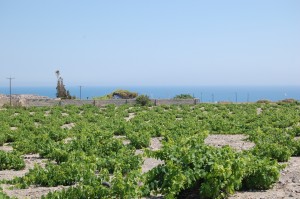Assyrtiko, Agiorgitiko, Xinomavro — oh my! All about Greece’s modern wines, and why you should be drinking them.
By Kelly A. Magyarics

Greece conjures up images of ancient monuments, crystal blue waters and pebbly beaches...but don't forget about the country's amazing wines! Photo credit Kelly Magyarics.
Recently I returned from an incredible 10-day trip exploring Greece and its wine regions, including Nemea, Mantinia, Crete and Santorini. While I had sampled a fair share of Greek wines before this adventure, having the chance to taste so many native wines (and indigenous grapes) side by side was an educational, eye-opening experience. My cohorts on the journey included other writers, wine educators and sommeliers from all over the country, who believe, as I do, that Greek wine is hot and worthy of more than a few spots in your cellar. Whether you are already a fan, or are new to the game, here are 10 things to know about this Mediterranean juice. Read up, and then race out to your local wine store to grab a few bottles:
Don’t skip over the Greek section of the wine list (or the Greek aisle in the wine store) just because you can’t pronounce the grapes. A few years ago, you probably didn’t know how to say Viognier or Grüner Veltliner, either. Santorini’s white wine Assyrtiko is pronounced “[ A seer tee ko ]”, red Agiortiko from Nemea is “[ Ah yor yee ti ko ]”, floral white Moschofilero from Mantinia is “[ Mos ko fee le ro ]”, and Xinomavro from Naoussa in Macedonia is “[ Ksee no ma vro ].” There, that wasn’t so hard, was it?
Greek wines are extremely food friendly…and not just with souvlaki, spanakopita and tzatziki.  Their vibrant acidity, (typically) low tannins and approachable styles mean that you can enjoy them with a variety of dishes and styles of cooking. Try elegant, citrus-y Rhoditis with oysters, or with whole grilled fish with lemon and herbs; sip a rosé made from Agiorgitiko with roast chicken, picnic fare or appetizers; and serve a bottle of dense, dark, chewy Xinomavro with red meats and/or dishes in rich, heavy sauces.
Their vibrant acidity, (typically) low tannins and approachable styles mean that you can enjoy them with a variety of dishes and styles of cooking. Try elegant, citrus-y Rhoditis with oysters, or with whole grilled fish with lemon and herbs; sip a rosé made from Agiorgitiko with roast chicken, picnic fare or appetizers; and serve a bottle of dense, dark, chewy Xinomavro with red meats and/or dishes in rich, heavy sauces.
If you’ve never tried Retsina, or if it’s been a number of years, go back for another taste. This style of white, which infuses pine resin into a white wine typically made from Savatiano, Assyrtiko or Athiri grapes, has been produced for over 2000 (!) years. While traditional styles were oxidized and high in alcohol, with an admittedly overt “Pine Sol” aroma and flavor, modern styles are much more approachable, with an attractive aroma that hints at eucalyptus and mint. Serve well-chilled Retsina with any dish containing a handful of fresh rosemary or mint to play up its herbal notes. It’s also fun to experiment with in cocktails, as its botanical profile can make it a fitting stand-in for gin. If you can find it, my favorite is made by Domaine Papagiannakos in Attica. More readily available is Kourtaki, with the easy to spot bright yellow label.
Greek dessert wines like Vin Santo and Samos are great alternatives to Tawny Port and Sauternes. Made with dried grapes, Vin Santo has gorgeous notes of dried raisins, prunes, apricot and honey on the palate. Samos Nectar has honey and blossom aromas, and a great line of acidity that keeps you going back, sip after sip. Kourtaki does a nice Muscat of Samos, and the Vin Santo from Gavalas on Santorini is unctuously delicious.

Santorini's volcanic ash soil renders high acid, mineral-driven white wines from the Assyrtiko grape. Photo credit Kelly Magyarics.
If you like crisp, mineral-drive white wines like Sauvignon Blanc and Vermentino, then you have to add Assyrtiko to your wine rotation. The best versions are produced by the twelve wineries on the breathtaking island of Santorini, where the volcanic-ash and rock-based soils lend a slate-y, mineral quality to the wines. Recent vintages fermented in stainless steel, as well as ones that are lightly done in non-new oak, allow the wine’s vibrant acidity and citrus to best come through. But since Assyrtiko is such a high acid wine, you can also age it 5-10 years, during which time it gains a wonderful complexity, including Riesling-like petrol notes. Look for producers Sigalas, Argyros and Gaia.
Agiorgitiko is a very versatile red grape, capable of producing crisp rosés, light reds and more complex, oak aged, age-worthy bottles. I was incredibly impressed with the Agiorgitiko-based rosés, which have an enticing rose petal and strawberry aroma. They are also very balanced, with candied lemon peel acidity, and an alcohol level that remains in check and makes them super sipp-able during the warmer months. Agiorgitiko vinified as a lighter-style red reminds me of a high quality Beaujolais — juicy, fruity, easy on the palate and so appealing. Do as the Greeks do and lightly chill it, then enjoy it out on the deck or on a picnic. Oak fermenting and ageing the grape leads to wines that are multi-layered and savory, with hints of smoke, leather and herbs in addition to red fruit. These bottles can be laid down for years…if you can hold onto them that long. Domaine Skouras, Boutari, Domaine Tselepos and Mercouri are readily available. **If the label lists Saint George, remember that this is another name for Agiorgitiko.
If you dig floral-scented whites, reach for Moschofilero. One look at the grape’s name and you can see that it might share some similarities with Muscat. It produces highly aromatic white wines with rose, jasmine, and grapey scents, and can also have a touch of spice on the palate like a Gewürztraminer. Seek out bottles from Mantinia, which produces the highest quality offerings, like Domaine Spiropoulos and Erasmios.
Love big reds like Syrah? Then opt for Xinomavro. The Naoussa region in Macedonia in Northern Greece is the hotbed for these big, dense, dark wines, with aromas

Me in the breathtaking vineyards of Peloponnese. Photo credit May Matta-Aliah.
of black fruit, good structure, full body and ample tannins. They can also have aromas of sun-dried tomatoes and spices, giving them a mouthwatering savory quality. Domaine Karydas, Uranos and Foundi are good bets.
In my experience, tourists drink Ouzo; natives instead sip Tsipouro or Raki. The latter are Greek versions of grappa, distilled from the pomace — what’s left of the grape after it’s been crushed and pressed during wine production. They are enjoyed with meze (small plates,) or as a shot after a large meal (perhaps as we did, before some traditional Cretan dancing — on Crete the spirit is called Tsikoudia.) Tsipouro and Raki are potent, but I also found them to have a softness on the palate about them that made them addictive to sip, especially chilled.
While Greek winemakers are blending their indigenous grapes with international varieties like Chardonnay, Cabernet Sauvignon and Syrah, it can be much more fun to experience the wines by themselves. After all, you can find these international varieties all over the world. I find it much more interesting to sip the stuff that’s been planted and made for thousands of years. Yamas! (Cheers)
Where to find Greek wines in the Washington, D.C. area:
Retail Stores:
I have done some research since I have returned to see what’s out there on store shelves. I am hard pressed to make specific recommendations for wines, since inventory, selection and vintage vary greatly. Your best bet is to pop in to your favorite wine store and see what they have available.
Restaurants:
Zaytinya (701 9th Street Northwest, 202-638-0800) has 18 Greek wines by the glass, including the 2010 Gaia Agiorgitiko Rosé ($9 glass/$36 bottle), 2010 Boutari Moschofilero ($9 glass/$36 bottle) and 2008 Domaine Skouras Agiorgitiko ($9 glass/$36 bottle.) You can also sample the NV Kechri Kechribari Retsina for $8 glass and $32 a bottle. Greece is also well-represented on the bottle list. And I was excited to see that they also stock Greek beer Mythos on the menu ($7), which my colleagues and I happily sipped after a long day of wine tasting that left our palates fatigued and our tongues craving something cold and effervescent.
Kellari Taverna (1700 K Street NW, 202-535-5274) offers about 15 Greek wines by the glass, including Domaine Tselepos Amalia Brut for $12 a flute, a delicately floral bubbly made from the Moschofilero grape that we sipped while touring the winery’s high altitude vineyards. You can get a bottle of 2010 Sigalas Assytiko from Santorini for $70, and over 80 other Greek options by the bottle.
For more information about Greek wines, visit New Wines of Greece.
Kelly Magyarics is a wine and spirits writer, and wine educator, in the Washington, D.C. area. She can be reached through her website, www.kellymagyarics.com, or on www.twitter.com/kmagyarics.
